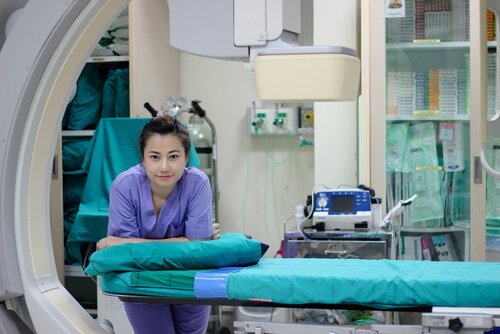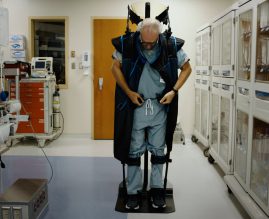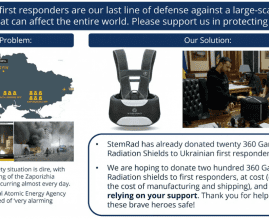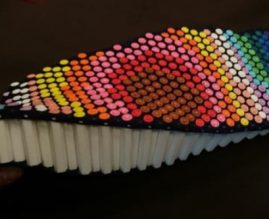Lightweight Lead – The Ultimate Protection for Physicians
08.20.20 | Thursday | Nofit Amir
Protection from radiation emitted by X-ray machines and fluoroscopic procedures is of the utmost importance. With lead being the gold standard in radiation protection, it is imperative for physicians and radiographers to use appropriate lead-lined protective garments when working with X-rays during diagnostics and therapeutic interventions. Lightweight lead is the latest upgrade from the standard, heavy lead-lined garments typically used.
Bilayer lead, which is lighter than traditionally used leaded gear, may be termed as the ultimate protection for physicians due to its capacity to block harmful X-rays while also qualifying as ‘lightweight lead.’
How dangerous is X-ray radiation?
X-rays occur naturally in the environment from various sources and can also be created using imaging technology. These rays comprise low-intensity ionizing radiation. X-rays are more prominently used in orthopedic imaging. With a dramatic rise in non-invasive surgical treatments, fluoroscopy machines are used to produce real-time moving images during procedures. Low-dosage radiation is unlikely to produce any immediate side effects in the short term. However, prolonged X-ray radiation has been linked to developing different types of cancer as it affects the body’s cellular structure. Studies have proven that lead offers the best protection from harmful X-ray radiation. Keeping practicality in mind while working with X-rays, lightweight lead has been introduced in order to protect physicians, radiographers, and others on the medical team.
What is the ultimate lightweight lead currently available?
StemRad has incorporated its lightweight lead technology into its patented exoskeletal design for next-gen lead apron, the StemRad MD. This has been further enhanced to suit doctors and interventionalists with ergonomically designed bilayer lead gear. The entire outfit consists of an exoskeleton that holds the lightweight lead apron, thyroid shield, and visor.
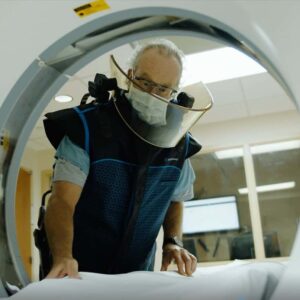
This exoskeleton allows exceptional mobility with hip and knee hinges to easily bend over the patient table when working in operating rooms. The visor perfectly interfaces with the thyroid collar and is angled in such a way that the user can easily look at the monitor while performing any medical procedure. In fact, there is no need for additional lead-lined eye gear and the individual can even wear prescription glasses. 100% of the weight of the radiation protective gear is carried by the exoskeleton and this is the essence of StemRad’s innovation.
With regard to radiation shielding, the visor specification is 0.30 mm lead eq. and attenuation of at least 91.5%. The thyroid collar is at 0.50 mm lead eq. and has an attenuation of at least 97.2%. The lightweight lead expanded protective apron is at 0.50 mm lead eq. on the front and sides, and 1.0 mm lead eq. in the overlap area in front.
Lightweight lead to protect physicians from harmful X-rays
Exposure to radiation from X-rays is very minimal in patients as they are hit with an extremely low dosage, and the duration is also very minimal. However, the physicians and accompanying radiologists are likely to be exposed to scatter radiation from the patient. Proximity to the X-ray or fluoroscopy machines – and to patients – increases the risk of harmful radiation exposure. Interventionalists are required, as a practice, to always wear lead-lined personal protective equipment (Radiation PPE) to reduce the amount of exposure. Bilayer lead offers wider coverage of exposed areas, which in turn means greater protection. With a lightweight lead, there are many more benefits than just radiation protection.
Lightweight lead in X-ray radiation shielding
Lead-lined clothing is heavy and difficult to move around in, as the density of elemental lead is high. What this means for physicians is other health hazards in addition to the prospect of radiation exposure. Wearing lead-lined radiation protection devices for long periods of time over many years has been associated with injuries of the spine, hips, and knees.
Lightweight lead clothing incorporates a lower amount of lead in the garments, while still ensuring protection from X-rays. Radiological advances have led to a number of upgrades in X-ray emitting equipment, with more targeted rays and better imaging, which negates the need for use of X-rays for longer durations. Bilayer lead is the upgrade most needed to keep up with this technology while keeping in mind the safety of physicians from both radiation and mobility issues from heavily leaded garments.
Use of lightweight lead by physicians and radiology interventionalists
Lightweight lead offers physicians and radiographers a far more secure and comfortable experience when working with experience. Due to the heaviness of lead-lined garments, not everyone is likely to wear the protective gear as detailed in radiology protocols. Improperly wearing the shielding aprons exposes other parts of the body to harmful radiation. Lightweight lead is easier to wear and does not compromise on the protection aspect.
The principle standard to follow with regard to radiation exposure is the As Low As Reasonably Achievable (ALARA) dosage regulation. Protective gear used by medical teams should at least 0.25mm lead eq. Lightweight lead gear also incorporates the minimum required lead but is designed to be worn in comfort and still be safe. In this regard, StemRad’s proprietary technology offers a revolutionary design in lightweight lead for physicians.
What are some best practices to enhance radiation protection with bilayer lead?
Radiation protection from X-rays requires more than just wearing lightweight lead garments. The most important protocol to follow is the ‘holy trinity’ of time, distance, and shielding. When it comes to radiology and interventional therapy using potentially harmful X-rays, medical teams should ensure to reduce the duration of exposure by controlling the fluoroscopy and imaging equipment, maintaining sufficient distance from the radiation equipment and the patients, and wearing lead-lined radiation protection garments in the right manner.
Medical teams should not only be well-equipped to handle radiation technology, but they should also be trained in the use and maintenance of these instruments, along with performing quality control checks at regular intervals. Personal dosimeters should be used to check the amount of radiation dosage in the individual, even if it is from scatter radiation. With the assistance provided by StemRad in the form of lightweight lead radiation shielding, physicians get the protection they need and the ergonomics of working comfortably without stress injuries.

Writes content for StemRad’s website, social media, and newsletter. She is an advocate with over twenty years of experience of writing high-end content in academic and industrial settings.
